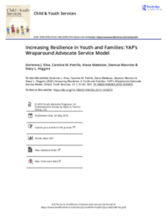Displaying 971 - 980 of 2215
Drawing on the extant literature, this chapter will present a multileveled discussion of the experiences of prejudice and bias foster youth face, with a focus on the systemic inequities among diverse youth in foster care, the individual challenges youth with different social identities face, socialization processes that can support these youth, and challenges foster parents face in supporting foster youths’ healthy identity development.
In this article, a team of practitioners explores the basis, implementation, research base, and future application of Youth Advocate Programs, Inc. (YAP)’s dual-prong service model in building resilience in youth and families in the U.S., providing comprehensive, community-based services as an alternative to institutionalization for youth and young adults with complex needs and challenges.
A sixteen year-old boy from Guatemala has died in US custody, the fifth child to die in migrant detention in the US since December, according to this article from the Guardian.
The present study uses the US National Youth in Transition Database (NYTD) to examine educational attainment, employment, homelessness, and incarceration for white, African-American, Hispanic, and American Indian/Alaska Native emancipated youth.
The present study uses system dynamics modeling to inform decision-making by testing policies for scaling the Family Unification Program (FUP), a U.S. federal initiative connecting inadequately housed families involved in child welfare with long-term rental subsidies to avoid foster placement.
This chapter will help the reader to understand the design and outcomes of the foster care system in the USA.
This chapter from Former Foster Youth in Postsecondary Education focuses on the transition point when youth begin to age out of care and may move into postsecondary education.
In this blog post for Hope and Homes for Children, Stephen Ucembe writes about the damaging impacts of orphanages in the African context.
This article from the New York Times tells the story of one 7 year-old boy from Honduras, José, who travelled to the US alone, being transported by smugglers from Mexico, to reunify with his mother in the US state of Texas, only to be placed in foster care in New York for 8 months.
In this study, the authors surveyed one hundred 4- to 11-year-olds removed from home because of maltreatment about their placement preferences. These results suggest that young children may express more mature preferences than recognized by the law, and that there may be value in asking even relatively young children about with whom they would like to live following removal from home as a result of maltreatment.

